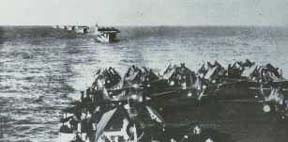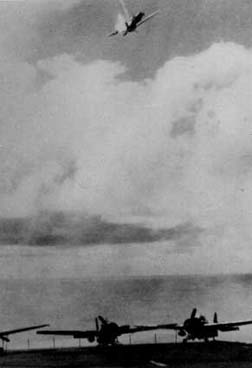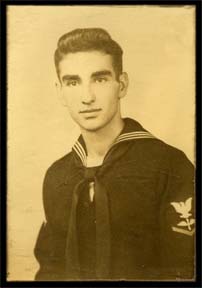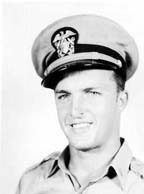CHAPTER 19
MARCH 21, 1945 -- MAY 26, 1945
OKINAWA OPERATION |
The following morning the entire 7th fleet sailed from Ulithi.
Once at sea we were to see no other ships other than our force
of escort carriers and their escort destroyers. My first view
of the CVEs was a line of twelve carriers from horizon to horizon.
I don't know how many there actually were in that line but I
do know that our particular force was made up of eighteen CVEs
and that we would be operating in three groups of six.
|
We arrived on station about sixty to eighty miles southeast of
Okinawa where the ships would remain for the next ninety days.
All of our flight operations would originate from this area.
The only times the ship would leave this area would be to rearm
from the supply ships at Kerama Retta, a group of small islands
about 10 miles west of Okinawa that |

Departing Ulithi for Okinawa |
formed an anchorage. These islands were invaded and secured for
that purpose. We arrived on March 25th and began combat missions
that day against Kerama Retta and Okinawa. It only took a couple
of days to secure the anchorage and for the supply ships and
troop ships to move in.
The first combat mission against Kerama Retta involved
a flight of fighter planes from VC 93. It was on one of the strafing
runs that an antiaircraft shell burst under the plane of Ensign
Tony LaMarco. A piece of shrapnel pierced the plane and struck
Tony in the butt causing him to be grounded for several days
. This was the first causality due to enemy action to be suffered
by the squadron. He survived, but unfortunately the wound leaves
a scar where Tony will not be able to show it off---- I don't
think?

VC 93 pilots on USS Petrof Bay |
On April 1, 1945 the invasion of Okinawa began and I was
in the first flight from the Petrof Bay to give direct support
to the Marines landing on the beach. The landing took place about
a mile from Yontan, the Japanese air field. Because we were flying
in from the sea and directly over the air field we were able
to strafe buildings, planes and anything else that came in our
sights. I'm sure that the |
planes we saw and strafed had been shot at before but there was
a certain amount of enjoyment in making the runs. On one run
I saw a fire break out under a camouflage netting. Even though
I didn't have any idea what other damage I might have caused
or how effective we were in supporting the Marines, I know that
I had left something burning.
On our final run we started at 10, 000 feet making a run on the
field firing all the way down. When we leveled off at about 100
feet I held the trigger down all the way across the field and
fired at a control tower as we pulled up over the hills on the
north side of field. When I released the trigger the guns were
so hot that they kept right on firing. The other three planes
in my flight made a left turn that took them over the landing
craft coming onto the beach. I was forced to fly straight ahead
until all my ammunition was expended so that I would not endanger
the landing force. I never found out but I'll bet those were
four 50 caliber machine guns that were of no use after that.
|
Although many of our flights were uneventful, especially
the local combat air patrols (LCAP), there were enough eventful
ones to give my adventuresome soul a lifetime of memories. The
uneventful flights do not stick in my memory but a majority of
the target combat air patrols (TCAP) flights usually had something
that I will never forget, especially those that ended up in disaster
or near disaster.
On March 27th, five days before the landings on Okinawa, the
squadron received mission orders for one TBM to drop propaganda
leaflets on several locations on the island. This mission was
assigned to Lt. (JG) Quentin Schenk, the pilot of the TBM and
his two aircrewmen, radioman Joseph Gebhardt, ARM3c and gunner
Price Seferian AMM2c. These leaflets were an appeal for the civilians
of |

Kamakazi attack on USS Petrof Bay
October 26, 1944 |
Okinawa to surrender themselves to the American troops to save
themselves from being wounded or killed in the coming invasion.
Schenk was in his first gliding approach over Naha, the capital
city of Okinawa, when the air around him suddenly turned into
a storm of antiaircraft fire. He took immediately evasive maneuvers
but not quick enough to avoid

Price Seferian, AMM2c
(Photo courtesy of Monica Seferian) |
being hit. He felt a sudden jar of the plane and the loss of
the hydraulic system and radio. He was not aware of the total
damage to the plane nor, due to the loss of communications, the
condition of his two crewmen. He knew that his mission was over
almost before it started and that he had better get back to the
ship while the plane was still able to fly. Schenk was not aware
until he was back aboard the carrier that an antiaircraft shell
had exploded in the observation compartment behind the cockpit
and forward of the gun turret and that a piece of shrapnel from
that shell had passed through Seferian's heart killing him instantly.
Seferian was the first death in the squadron to be caused by
the enemy. The next day Seferian was buried at sea |
with full military honors. This was the first burial service
at sea I was to witness but would not be the last. Most of the
deaths in this frame of time occurred when a plane was lost at
sea or in enemy territory and were not recovered. The leaflet
canisters were transferred to another plane and the leaflets
delivered to Okinawa later the same day.
|
Three days later Ensign Gordon Collipriest was killed in a
mid-air collision with a plane from another squadron. For some
reason he wasn't missed until his group landed and he wasn't
there. A short time later the other pilot involved made it back
to his ship and reported the collision.
Twenty one years later my wife, son, daughter and I were vacationing
in Hawaii where we visited the Punch Bowl cemetery. On a wall
where all the servicemen that are missing in the pacific are
listed, the names of our missing are listed with the exception
of Ensign Collipriest. Don't understand why! |

Ensign G. Alan Collipriest |
(Update: In April, 2001 I received
a comment in the guestbook of this website
from the younger brother of Ensign Alan Collipriest. This comment
was
followed by an E-mail from the younger Mr. Collipriest informing
me that Alan
had been involved in a collision with an aircraft from one of
the other
squadrons and Alan's plane crashed near the beach. Alan's body
was recovered
and was buried in the Marine's Seventh Division cemetery on Okinawa.
After
the war his body was removed and returned to Salt Lake City and
is buried
there. This information was apparently known to the Navy prior
to August
1945 and was certainly known by our squadron commander by the
end of December
1945. Since I had no contact with any member of my squadron,
including the
skipper, from August 1945 until 1984 I was unaware of this information.
No
mention was made of this information at that reunion or any of
the reunions
since 1984. I surmise none of the other member of the squadron
know any of
this story).

Ensign Charles Janson |
On April 12, the day President Roosevelt died, Ensign Janson,
whom I mentioned earlier in our double dating adventures in Long
Beach, was also killed in a midair collision. Because of the
interesting story that goes with this accident I will relate
it later. On June 15th Ensign George Vigeant was killed when
his plane exploded while making a water landing after being hit
by antiaircraft fire. On July 20th airman A.R. Katough was drowned
when the TBM he was riding in crashed while taking off the carrier.
He was pinned in the plane when it was struck by the carrier.
The pilot and gunner got him out and aboard the rescue destroyer
but they were unable to revive him. |
My squadron lost several planes at the hands of the enemy but
I am willing to bet that we lost more without their help. Certainly
we lost more than double the number that we are credited with
shooting down.
|